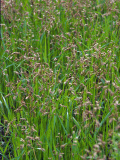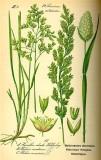- Store
- >
- Grains and Grasses
- >
- 20 Sweetgrass Seeds, Hierochloe odorata, 'Bison grass' -PM
20 Sweetgrass Seeds, Hierochloe odorata, 'Bison grass' -PM
Packs of 20 seeds. I often have live plants for sale.
Sacred plant to many North American tribes. AKA Bison grass, Vanilla grass, Holy grass. Germination is low, 10% or less. Best is to buy a plant.
Many Native Americans burned Sweet Grass to invite the presence of good Spirits. Sweet Grass is an aromatic, cool-season perennial growing 10-24 inches in height and spreading about two feet per year by underground rhizomes. Its natural habitat is wetlands, prairies, and savannas. Germination is normally only 5-10%.
Although Sweet Grass prefers rich, moist soils, it will grow in almost any soil that receives a minimum of a half day of sun.
Modern tests show that Sweetgrass contains courmarin, a phytochemical with a vanilla-like flavor known for its medicinal value (courmarin is also found naturally in turmeric). Rare and hard to find seeds.
Easy to grow, plant will spread out through runners even more than by seeds.
To many North American indigenous cultures, Sweet Grass is considered a sacred plant used in prayer, smudging, and other ceremonies. "Smudging" refers to a ceremony that calls on the Spirits of Sacred plants to purify a person or space. Oftentimes, Sweet Grass is used in conjunction with sage, cedar, and tobacco. If you choose not to burn the Sweet Grass braid, the aromatic smell will remain for years!
How to HARVEST, DRY, and BRAID your own grass:
If Sweet Grass receives adequate rainfall or irrigation, it will actively grow from spring to fall. Harvesting can take place in either summer or early fall. Early harvest may be more aromatic, but leaves will be shorter. Watch for foliage starting to go dormant from lack of moisture or colder fall temperatures. Leaves will lighten in color as they bleach from the sun and lose some of their scent. Complete the harvest by this time. As you are cutting, tie grass bundles in approximately 1 1/2" in diameter (rubber bands work well) and hang in a dry, ventilated area out of the sunlight. Before braiding, reconstitute bundles by submerging in water only until thoroughly moistened, but not longer than necessary. Wrap moistened bundles in a towel for at least 15 minutes to allow water to be absorbed. Braid when pliable and allow to dry thoroughly before storing.
Note: Sweetgrass seeds typically have a low germination rate, around 5-10%. This is due to a biological limitation in sweetgrass flowers to produce viable seeds. Fortunately, a single seedling can produce hundreds of plants because the roots produce many rhizomes which develop into new plants and can be wonderfully invasive.
Sweetgrass is a circumboreal plant which is common above 40 degrees north latitude in Asia, Europe, and North America. In North America this fragrant grass grows regionally from Labrador to Alaska, and south to New Jersy, Ohio, Illinois, Iowa, South Dakota, Arizona and Washington. Sweetgrass can be found growing wild in wet meadows, low prairies, the edges of sloughs and marshes, bogs, shaded streambanks, lakeshores, and cool mountain canyons. Sweetgrass rhizomes and roots form a dense mat beneath the soil surface.
Sweetgrass flowers from June through August and is easily identified by the sweet vanilla-like fragrance of its leaves, its three-flowered spikelets and its hairy lemmas. The Sweetgrass flowers are arranged in a panicle up to 4 inches long. The spikelets themselves are about 1/4 inch long (the lower two flowers are male only, while the upper flower has both stamens and pistils).
Sweetgrass usually grows among other grasses or shrubs; it is seldom found in pure stands. Dried Sweetgrass foliage is fragrant because of its coumarin content. Sweetgrass is traditionally harvested in late June or early July. Sweetgrass harvested after exposure to frost has little sent. Care should be taken to cut Sweetgrass leaves and not to pull the grass up by its roots so it can grow again the next year. Weeding Sweetgrass areas lessens competition from other plants. USDA Zones 3-7.







